Analyzing CSR Innovation: A Report on Woolworths Australia's Approach
VerifiedAdded on 2023/04/23
|12
|3579
|80
Report
AI Summary
This report delves into Woolworths Australia's Corporate Social Responsibility (CSR) initiatives, examining the challenges and innovative responses the company has adopted. It highlights the importance of CSR in enhancing customer and employee loyalty and discusses the internal and external factors influencing CSR strategies. The report emphasizes Woolworths' need to demonstrate community support and increase its competitive advantage through socially responsible interventions. Key ideas for innovation include developing a long-term sustainability program focused on reducing carbon emissions, repackaging products, and recycling waste, as well as increasing community participation and transparency. The strategic innovation model, encompassing dimensions like manageable innovation processes, strategic alignment, industry foresight, customer insights, core technologies, organizational readiness, and disciplined implementation, is discussed as a framework for enhancing growth. Furthermore, the report advocates for a transformational leadership approach to effectively implement CSR policies, motivating employees and stakeholders to embrace the company's social and strategic CSR activities for long-term organizational success. The report concludes by emphasizing the importance of ethical considerations and regulatory compliance in CSR activities.
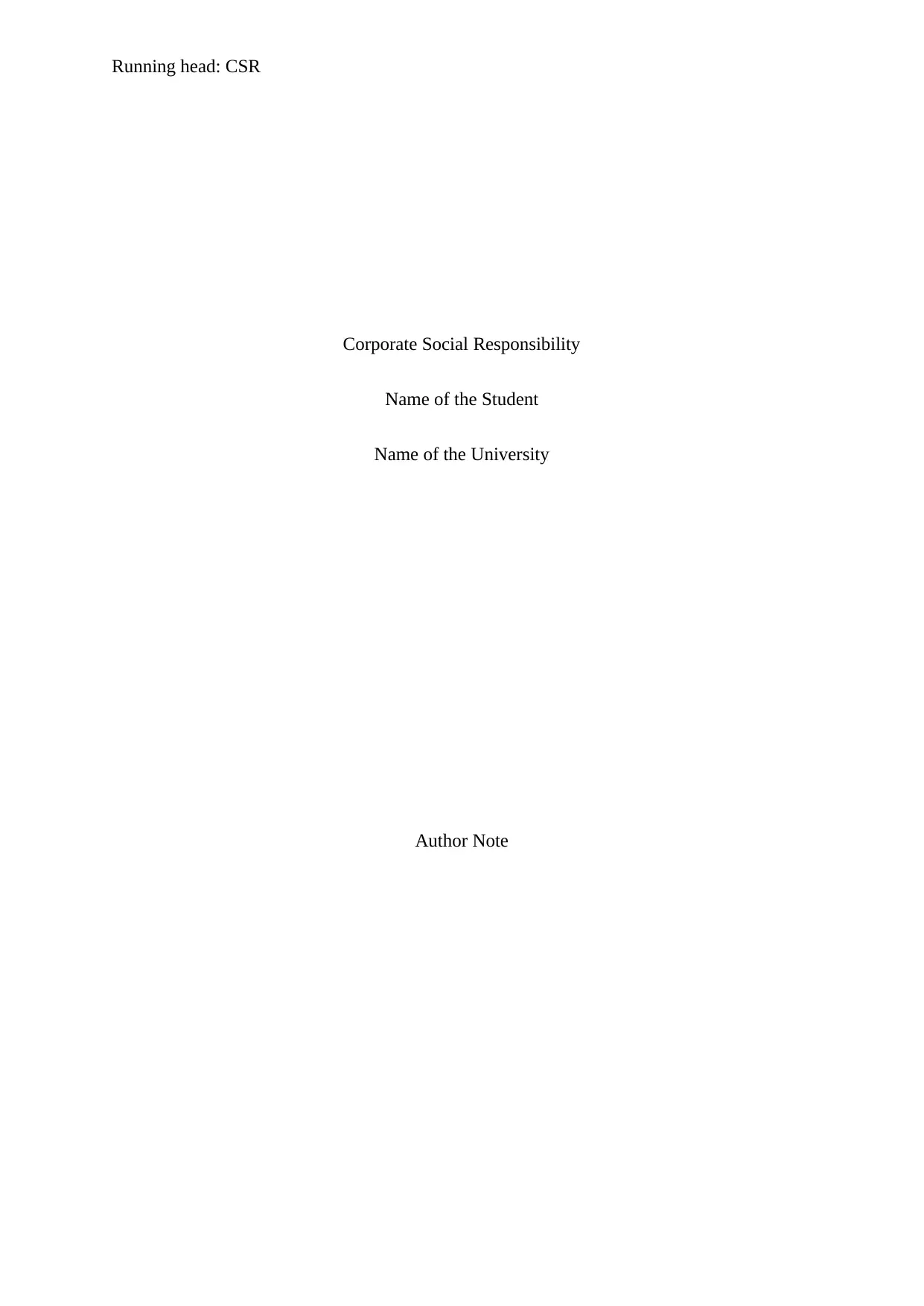
Running head: CSR
Corporate Social Responsibility
Name of the Student
Name of the University
Author Note
Corporate Social Responsibility
Name of the Student
Name of the University
Author Note
Paraphrase This Document
Need a fresh take? Get an instant paraphrase of this document with our AI Paraphraser
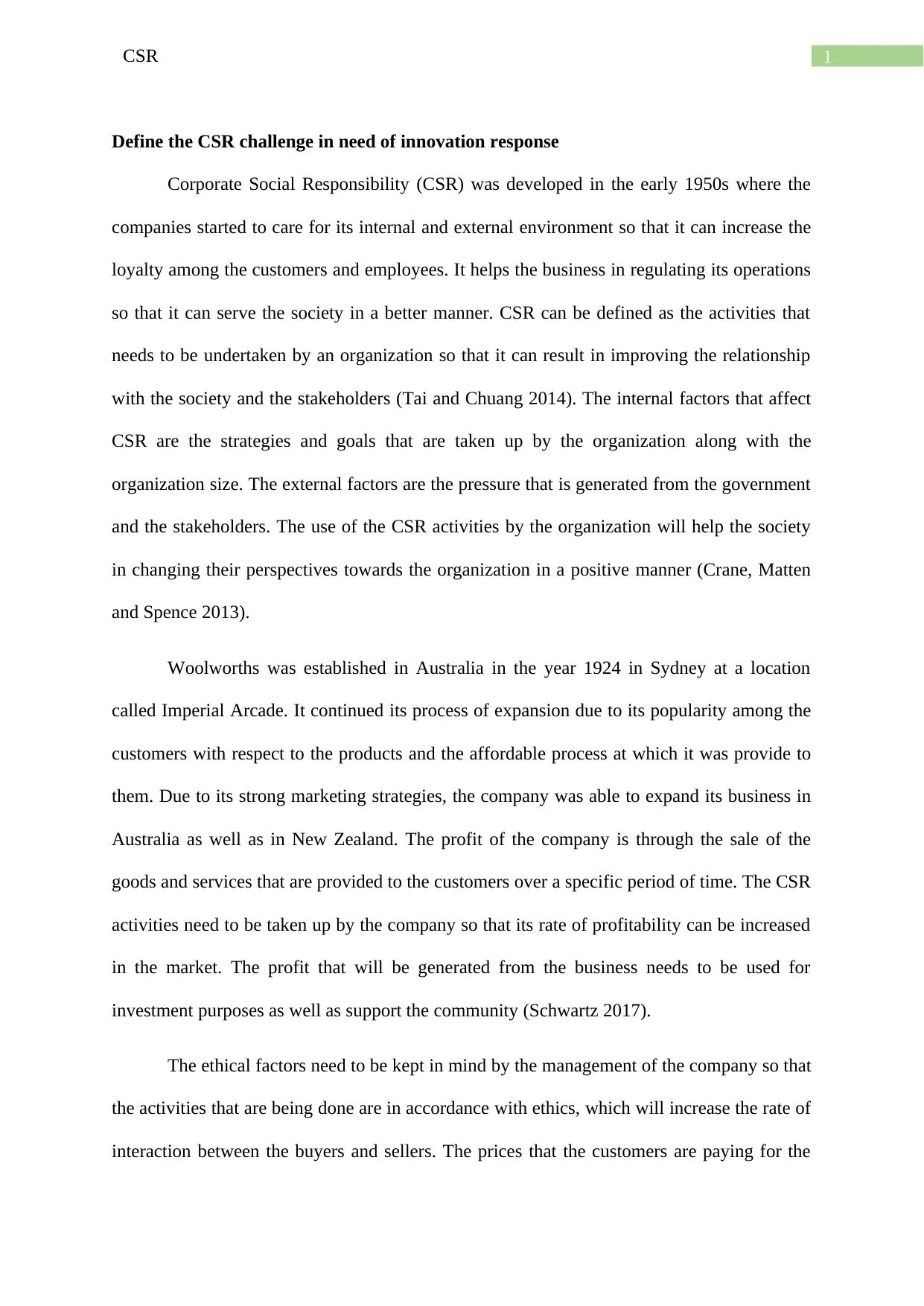
1CSR
Define the CSR challenge in need of innovation response
Corporate Social Responsibility (CSR) was developed in the early 1950s where the
companies started to care for its internal and external environment so that it can increase the
loyalty among the customers and employees. It helps the business in regulating its operations
so that it can serve the society in a better manner. CSR can be defined as the activities that
needs to be undertaken by an organization so that it can result in improving the relationship
with the society and the stakeholders (Tai and Chuang 2014). The internal factors that affect
CSR are the strategies and goals that are taken up by the organization along with the
organization size. The external factors are the pressure that is generated from the government
and the stakeholders. The use of the CSR activities by the organization will help the society
in changing their perspectives towards the organization in a positive manner (Crane, Matten
and Spence 2013).
Woolworths was established in Australia in the year 1924 in Sydney at a location
called Imperial Arcade. It continued its process of expansion due to its popularity among the
customers with respect to the products and the affordable process at which it was provide to
them. Due to its strong marketing strategies, the company was able to expand its business in
Australia as well as in New Zealand. The profit of the company is through the sale of the
goods and services that are provided to the customers over a specific period of time. The CSR
activities need to be taken up by the company so that its rate of profitability can be increased
in the market. The profit that will be generated from the business needs to be used for
investment purposes as well as support the community (Schwartz 2017).
The ethical factors need to be kept in mind by the management of the company so that
the activities that are being done are in accordance with ethics, which will increase the rate of
interaction between the buyers and sellers. The prices that the customers are paying for the
Define the CSR challenge in need of innovation response
Corporate Social Responsibility (CSR) was developed in the early 1950s where the
companies started to care for its internal and external environment so that it can increase the
loyalty among the customers and employees. It helps the business in regulating its operations
so that it can serve the society in a better manner. CSR can be defined as the activities that
needs to be undertaken by an organization so that it can result in improving the relationship
with the society and the stakeholders (Tai and Chuang 2014). The internal factors that affect
CSR are the strategies and goals that are taken up by the organization along with the
organization size. The external factors are the pressure that is generated from the government
and the stakeholders. The use of the CSR activities by the organization will help the society
in changing their perspectives towards the organization in a positive manner (Crane, Matten
and Spence 2013).
Woolworths was established in Australia in the year 1924 in Sydney at a location
called Imperial Arcade. It continued its process of expansion due to its popularity among the
customers with respect to the products and the affordable process at which it was provide to
them. Due to its strong marketing strategies, the company was able to expand its business in
Australia as well as in New Zealand. The profit of the company is through the sale of the
goods and services that are provided to the customers over a specific period of time. The CSR
activities need to be taken up by the company so that its rate of profitability can be increased
in the market. The profit that will be generated from the business needs to be used for
investment purposes as well as support the community (Schwartz 2017).
The ethical factors need to be kept in mind by the management of the company so that
the activities that are being done are in accordance with ethics, which will increase the rate of
interaction between the buyers and sellers. The prices that the customers are paying for the
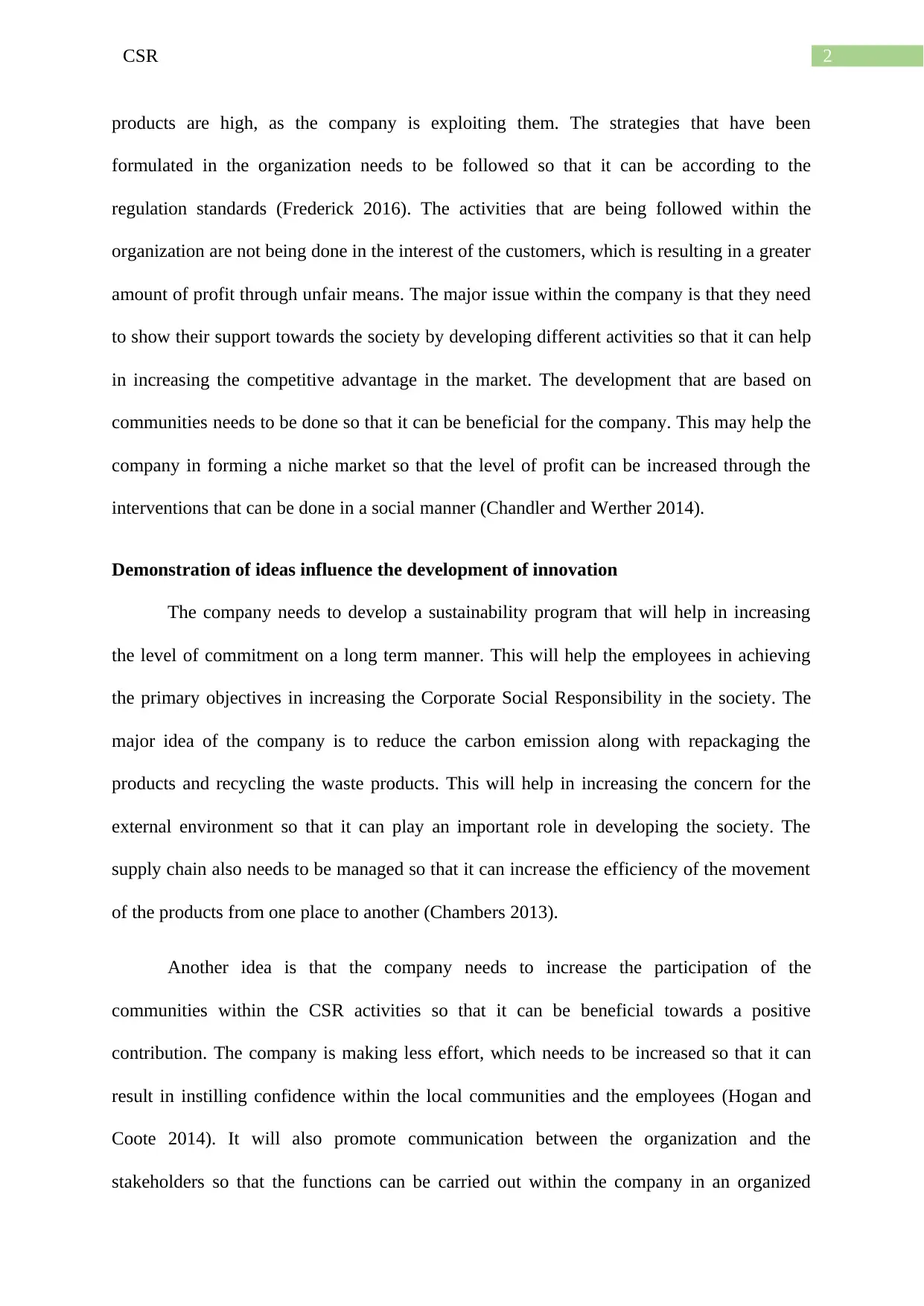
2CSR
products are high, as the company is exploiting them. The strategies that have been
formulated in the organization needs to be followed so that it can be according to the
regulation standards (Frederick 2016). The activities that are being followed within the
organization are not being done in the interest of the customers, which is resulting in a greater
amount of profit through unfair means. The major issue within the company is that they need
to show their support towards the society by developing different activities so that it can help
in increasing the competitive advantage in the market. The development that are based on
communities needs to be done so that it can be beneficial for the company. This may help the
company in forming a niche market so that the level of profit can be increased through the
interventions that can be done in a social manner (Chandler and Werther 2014).
Demonstration of ideas influence the development of innovation
The company needs to develop a sustainability program that will help in increasing
the level of commitment on a long term manner. This will help the employees in achieving
the primary objectives in increasing the Corporate Social Responsibility in the society. The
major idea of the company is to reduce the carbon emission along with repackaging the
products and recycling the waste products. This will help in increasing the concern for the
external environment so that it can play an important role in developing the society. The
supply chain also needs to be managed so that it can increase the efficiency of the movement
of the products from one place to another (Chambers 2013).
Another idea is that the company needs to increase the participation of the
communities within the CSR activities so that it can be beneficial towards a positive
contribution. The company is making less effort, which needs to be increased so that it can
result in instilling confidence within the local communities and the employees (Hogan and
Coote 2014). It will also promote communication between the organization and the
stakeholders so that the functions can be carried out within the company in an organized
products are high, as the company is exploiting them. The strategies that have been
formulated in the organization needs to be followed so that it can be according to the
regulation standards (Frederick 2016). The activities that are being followed within the
organization are not being done in the interest of the customers, which is resulting in a greater
amount of profit through unfair means. The major issue within the company is that they need
to show their support towards the society by developing different activities so that it can help
in increasing the competitive advantage in the market. The development that are based on
communities needs to be done so that it can be beneficial for the company. This may help the
company in forming a niche market so that the level of profit can be increased through the
interventions that can be done in a social manner (Chandler and Werther 2014).
Demonstration of ideas influence the development of innovation
The company needs to develop a sustainability program that will help in increasing
the level of commitment on a long term manner. This will help the employees in achieving
the primary objectives in increasing the Corporate Social Responsibility in the society. The
major idea of the company is to reduce the carbon emission along with repackaging the
products and recycling the waste products. This will help in increasing the concern for the
external environment so that it can play an important role in developing the society. The
supply chain also needs to be managed so that it can increase the efficiency of the movement
of the products from one place to another (Chambers 2013).
Another idea is that the company needs to increase the participation of the
communities within the CSR activities so that it can be beneficial towards a positive
contribution. The company is making less effort, which needs to be increased so that it can
result in instilling confidence within the local communities and the employees (Hogan and
Coote 2014). It will also promote communication between the organization and the
stakeholders so that the functions can be carried out within the company in an organized
⊘ This is a preview!⊘
Do you want full access?
Subscribe today to unlock all pages.

Trusted by 1+ million students worldwide
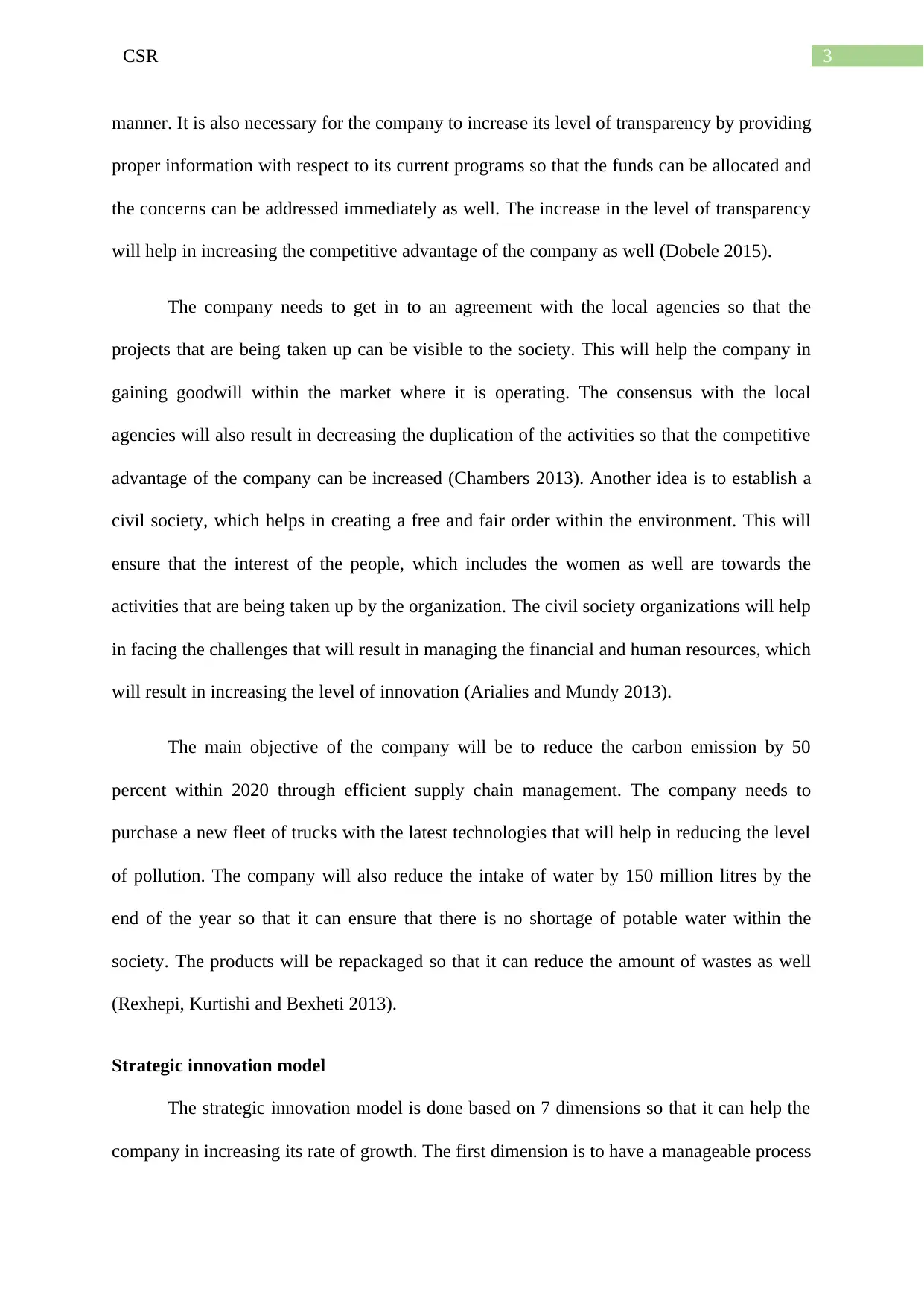
3CSR
manner. It is also necessary for the company to increase its level of transparency by providing
proper information with respect to its current programs so that the funds can be allocated and
the concerns can be addressed immediately as well. The increase in the level of transparency
will help in increasing the competitive advantage of the company as well (Dobele 2015).
The company needs to get in to an agreement with the local agencies so that the
projects that are being taken up can be visible to the society. This will help the company in
gaining goodwill within the market where it is operating. The consensus with the local
agencies will also result in decreasing the duplication of the activities so that the competitive
advantage of the company can be increased (Chambers 2013). Another idea is to establish a
civil society, which helps in creating a free and fair order within the environment. This will
ensure that the interest of the people, which includes the women as well are towards the
activities that are being taken up by the organization. The civil society organizations will help
in facing the challenges that will result in managing the financial and human resources, which
will result in increasing the level of innovation (Arialies and Mundy 2013).
The main objective of the company will be to reduce the carbon emission by 50
percent within 2020 through efficient supply chain management. The company needs to
purchase a new fleet of trucks with the latest technologies that will help in reducing the level
of pollution. The company will also reduce the intake of water by 150 million litres by the
end of the year so that it can ensure that there is no shortage of potable water within the
society. The products will be repackaged so that it can reduce the amount of wastes as well
(Rexhepi, Kurtishi and Bexheti 2013).
Strategic innovation model
The strategic innovation model is done based on 7 dimensions so that it can help the
company in increasing its rate of growth. The first dimension is to have a manageable process
manner. It is also necessary for the company to increase its level of transparency by providing
proper information with respect to its current programs so that the funds can be allocated and
the concerns can be addressed immediately as well. The increase in the level of transparency
will help in increasing the competitive advantage of the company as well (Dobele 2015).
The company needs to get in to an agreement with the local agencies so that the
projects that are being taken up can be visible to the society. This will help the company in
gaining goodwill within the market where it is operating. The consensus with the local
agencies will also result in decreasing the duplication of the activities so that the competitive
advantage of the company can be increased (Chambers 2013). Another idea is to establish a
civil society, which helps in creating a free and fair order within the environment. This will
ensure that the interest of the people, which includes the women as well are towards the
activities that are being taken up by the organization. The civil society organizations will help
in facing the challenges that will result in managing the financial and human resources, which
will result in increasing the level of innovation (Arialies and Mundy 2013).
The main objective of the company will be to reduce the carbon emission by 50
percent within 2020 through efficient supply chain management. The company needs to
purchase a new fleet of trucks with the latest technologies that will help in reducing the level
of pollution. The company will also reduce the intake of water by 150 million litres by the
end of the year so that it can ensure that there is no shortage of potable water within the
society. The products will be repackaged so that it can reduce the amount of wastes as well
(Rexhepi, Kurtishi and Bexheti 2013).
Strategic innovation model
The strategic innovation model is done based on 7 dimensions so that it can help the
company in increasing its rate of growth. The first dimension is to have a manageable process
Paraphrase This Document
Need a fresh take? Get an instant paraphrase of this document with our AI Paraphraser
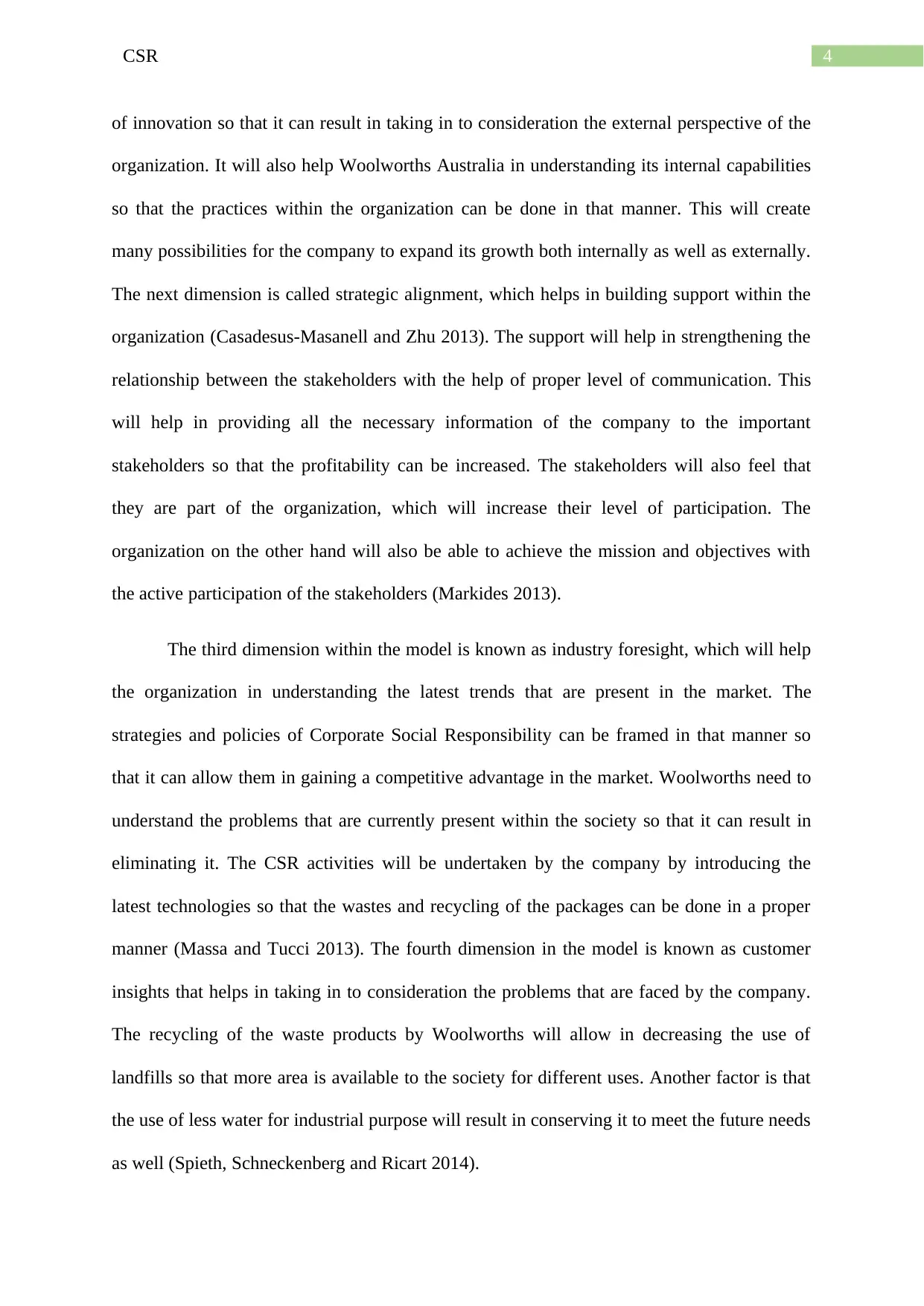
4CSR
of innovation so that it can result in taking in to consideration the external perspective of the
organization. It will also help Woolworths Australia in understanding its internal capabilities
so that the practices within the organization can be done in that manner. This will create
many possibilities for the company to expand its growth both internally as well as externally.
The next dimension is called strategic alignment, which helps in building support within the
organization (Casadesus-Masanell and Zhu 2013). The support will help in strengthening the
relationship between the stakeholders with the help of proper level of communication. This
will help in providing all the necessary information of the company to the important
stakeholders so that the profitability can be increased. The stakeholders will also feel that
they are part of the organization, which will increase their level of participation. The
organization on the other hand will also be able to achieve the mission and objectives with
the active participation of the stakeholders (Markides 2013).
The third dimension within the model is known as industry foresight, which will help
the organization in understanding the latest trends that are present in the market. The
strategies and policies of Corporate Social Responsibility can be framed in that manner so
that it can allow them in gaining a competitive advantage in the market. Woolworths need to
understand the problems that are currently present within the society so that it can result in
eliminating it. The CSR activities will be undertaken by the company by introducing the
latest technologies so that the wastes and recycling of the packages can be done in a proper
manner (Massa and Tucci 2013). The fourth dimension in the model is known as customer
insights that helps in taking in to consideration the problems that are faced by the company.
The recycling of the waste products by Woolworths will allow in decreasing the use of
landfills so that more area is available to the society for different uses. Another factor is that
the use of less water for industrial purpose will result in conserving it to meet the future needs
as well (Spieth, Schneckenberg and Ricart 2014).
of innovation so that it can result in taking in to consideration the external perspective of the
organization. It will also help Woolworths Australia in understanding its internal capabilities
so that the practices within the organization can be done in that manner. This will create
many possibilities for the company to expand its growth both internally as well as externally.
The next dimension is called strategic alignment, which helps in building support within the
organization (Casadesus-Masanell and Zhu 2013). The support will help in strengthening the
relationship between the stakeholders with the help of proper level of communication. This
will help in providing all the necessary information of the company to the important
stakeholders so that the profitability can be increased. The stakeholders will also feel that
they are part of the organization, which will increase their level of participation. The
organization on the other hand will also be able to achieve the mission and objectives with
the active participation of the stakeholders (Markides 2013).
The third dimension within the model is known as industry foresight, which will help
the organization in understanding the latest trends that are present in the market. The
strategies and policies of Corporate Social Responsibility can be framed in that manner so
that it can allow them in gaining a competitive advantage in the market. Woolworths need to
understand the problems that are currently present within the society so that it can result in
eliminating it. The CSR activities will be undertaken by the company by introducing the
latest technologies so that the wastes and recycling of the packages can be done in a proper
manner (Massa and Tucci 2013). The fourth dimension in the model is known as customer
insights that helps in taking in to consideration the problems that are faced by the company.
The recycling of the waste products by Woolworths will allow in decreasing the use of
landfills so that more area is available to the society for different uses. Another factor is that
the use of less water for industrial purpose will result in conserving it to meet the future needs
as well (Spieth, Schneckenberg and Ricart 2014).
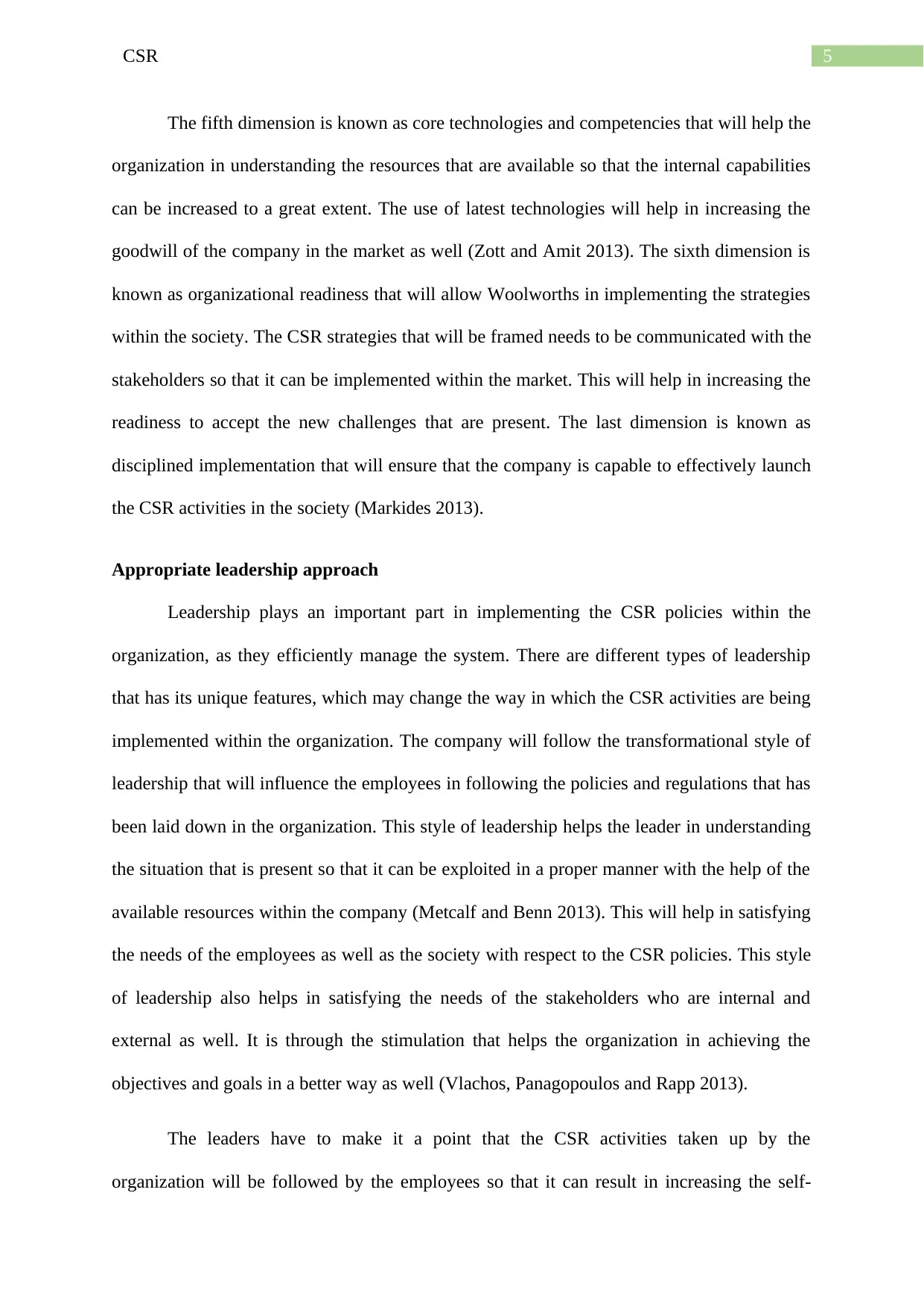
5CSR
The fifth dimension is known as core technologies and competencies that will help the
organization in understanding the resources that are available so that the internal capabilities
can be increased to a great extent. The use of latest technologies will help in increasing the
goodwill of the company in the market as well (Zott and Amit 2013). The sixth dimension is
known as organizational readiness that will allow Woolworths in implementing the strategies
within the society. The CSR strategies that will be framed needs to be communicated with the
stakeholders so that it can be implemented within the market. This will help in increasing the
readiness to accept the new challenges that are present. The last dimension is known as
disciplined implementation that will ensure that the company is capable to effectively launch
the CSR activities in the society (Markides 2013).
Appropriate leadership approach
Leadership plays an important part in implementing the CSR policies within the
organization, as they efficiently manage the system. There are different types of leadership
that has its unique features, which may change the way in which the CSR activities are being
implemented within the organization. The company will follow the transformational style of
leadership that will influence the employees in following the policies and regulations that has
been laid down in the organization. This style of leadership helps the leader in understanding
the situation that is present so that it can be exploited in a proper manner with the help of the
available resources within the company (Metcalf and Benn 2013). This will help in satisfying
the needs of the employees as well as the society with respect to the CSR policies. This style
of leadership also helps in satisfying the needs of the stakeholders who are internal and
external as well. It is through the stimulation that helps the organization in achieving the
objectives and goals in a better way as well (Vlachos, Panagopoulos and Rapp 2013).
The leaders have to make it a point that the CSR activities taken up by the
organization will be followed by the employees so that it can result in increasing the self-
The fifth dimension is known as core technologies and competencies that will help the
organization in understanding the resources that are available so that the internal capabilities
can be increased to a great extent. The use of latest technologies will help in increasing the
goodwill of the company in the market as well (Zott and Amit 2013). The sixth dimension is
known as organizational readiness that will allow Woolworths in implementing the strategies
within the society. The CSR strategies that will be framed needs to be communicated with the
stakeholders so that it can be implemented within the market. This will help in increasing the
readiness to accept the new challenges that are present. The last dimension is known as
disciplined implementation that will ensure that the company is capable to effectively launch
the CSR activities in the society (Markides 2013).
Appropriate leadership approach
Leadership plays an important part in implementing the CSR policies within the
organization, as they efficiently manage the system. There are different types of leadership
that has its unique features, which may change the way in which the CSR activities are being
implemented within the organization. The company will follow the transformational style of
leadership that will influence the employees in following the policies and regulations that has
been laid down in the organization. This style of leadership helps the leader in understanding
the situation that is present so that it can be exploited in a proper manner with the help of the
available resources within the company (Metcalf and Benn 2013). This will help in satisfying
the needs of the employees as well as the society with respect to the CSR policies. This style
of leadership also helps in satisfying the needs of the stakeholders who are internal and
external as well. It is through the stimulation that helps the organization in achieving the
objectives and goals in a better way as well (Vlachos, Panagopoulos and Rapp 2013).
The leaders have to make it a point that the CSR activities taken up by the
organization will be followed by the employees so that it can result in increasing the self-
⊘ This is a preview!⊘
Do you want full access?
Subscribe today to unlock all pages.

Trusted by 1+ million students worldwide
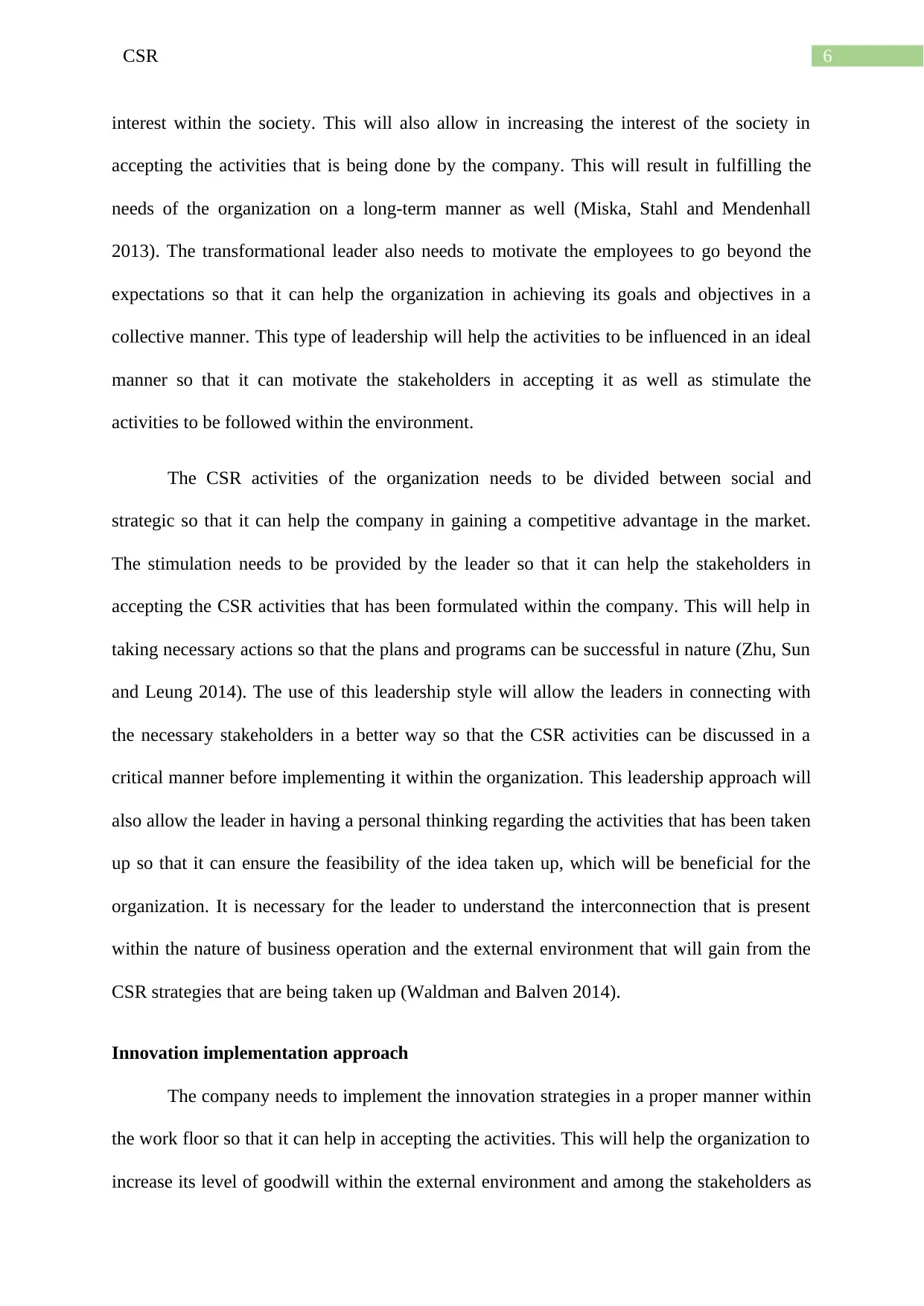
6CSR
interest within the society. This will also allow in increasing the interest of the society in
accepting the activities that is being done by the company. This will result in fulfilling the
needs of the organization on a long-term manner as well (Miska, Stahl and Mendenhall
2013). The transformational leader also needs to motivate the employees to go beyond the
expectations so that it can help the organization in achieving its goals and objectives in a
collective manner. This type of leadership will help the activities to be influenced in an ideal
manner so that it can motivate the stakeholders in accepting it as well as stimulate the
activities to be followed within the environment.
The CSR activities of the organization needs to be divided between social and
strategic so that it can help the company in gaining a competitive advantage in the market.
The stimulation needs to be provided by the leader so that it can help the stakeholders in
accepting the CSR activities that has been formulated within the company. This will help in
taking necessary actions so that the plans and programs can be successful in nature (Zhu, Sun
and Leung 2014). The use of this leadership style will allow the leaders in connecting with
the necessary stakeholders in a better way so that the CSR activities can be discussed in a
critical manner before implementing it within the organization. This leadership approach will
also allow the leader in having a personal thinking regarding the activities that has been taken
up so that it can ensure the feasibility of the idea taken up, which will be beneficial for the
organization. It is necessary for the leader to understand the interconnection that is present
within the nature of business operation and the external environment that will gain from the
CSR strategies that are being taken up (Waldman and Balven 2014).
Innovation implementation approach
The company needs to implement the innovation strategies in a proper manner within
the work floor so that it can help in accepting the activities. This will help the organization to
increase its level of goodwill within the external environment and among the stakeholders as
interest within the society. This will also allow in increasing the interest of the society in
accepting the activities that is being done by the company. This will result in fulfilling the
needs of the organization on a long-term manner as well (Miska, Stahl and Mendenhall
2013). The transformational leader also needs to motivate the employees to go beyond the
expectations so that it can help the organization in achieving its goals and objectives in a
collective manner. This type of leadership will help the activities to be influenced in an ideal
manner so that it can motivate the stakeholders in accepting it as well as stimulate the
activities to be followed within the environment.
The CSR activities of the organization needs to be divided between social and
strategic so that it can help the company in gaining a competitive advantage in the market.
The stimulation needs to be provided by the leader so that it can help the stakeholders in
accepting the CSR activities that has been formulated within the company. This will help in
taking necessary actions so that the plans and programs can be successful in nature (Zhu, Sun
and Leung 2014). The use of this leadership style will allow the leaders in connecting with
the necessary stakeholders in a better way so that the CSR activities can be discussed in a
critical manner before implementing it within the organization. This leadership approach will
also allow the leader in having a personal thinking regarding the activities that has been taken
up so that it can ensure the feasibility of the idea taken up, which will be beneficial for the
organization. It is necessary for the leader to understand the interconnection that is present
within the nature of business operation and the external environment that will gain from the
CSR strategies that are being taken up (Waldman and Balven 2014).
Innovation implementation approach
The company needs to implement the innovation strategies in a proper manner within
the work floor so that it can help in accepting the activities. This will help the organization to
increase its level of goodwill within the external environment and among the stakeholders as
Paraphrase This Document
Need a fresh take? Get an instant paraphrase of this document with our AI Paraphraser
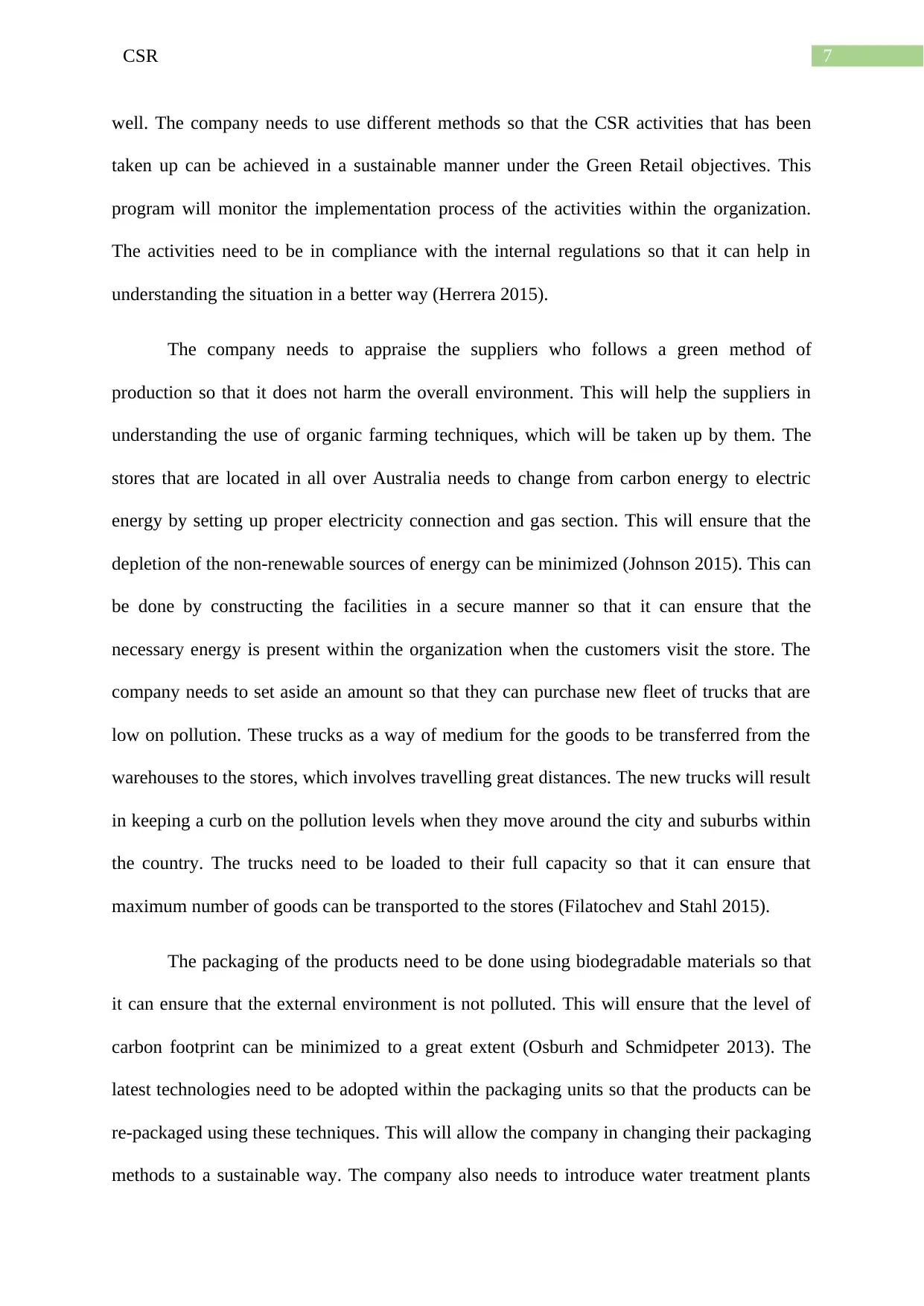
7CSR
well. The company needs to use different methods so that the CSR activities that has been
taken up can be achieved in a sustainable manner under the Green Retail objectives. This
program will monitor the implementation process of the activities within the organization.
The activities need to be in compliance with the internal regulations so that it can help in
understanding the situation in a better way (Herrera 2015).
The company needs to appraise the suppliers who follows a green method of
production so that it does not harm the overall environment. This will help the suppliers in
understanding the use of organic farming techniques, which will be taken up by them. The
stores that are located in all over Australia needs to change from carbon energy to electric
energy by setting up proper electricity connection and gas section. This will ensure that the
depletion of the non-renewable sources of energy can be minimized (Johnson 2015). This can
be done by constructing the facilities in a secure manner so that it can ensure that the
necessary energy is present within the organization when the customers visit the store. The
company needs to set aside an amount so that they can purchase new fleet of trucks that are
low on pollution. These trucks as a way of medium for the goods to be transferred from the
warehouses to the stores, which involves travelling great distances. The new trucks will result
in keeping a curb on the pollution levels when they move around the city and suburbs within
the country. The trucks need to be loaded to their full capacity so that it can ensure that
maximum number of goods can be transported to the stores (Filatochev and Stahl 2015).
The packaging of the products need to be done using biodegradable materials so that
it can ensure that the external environment is not polluted. This will ensure that the level of
carbon footprint can be minimized to a great extent (Osburh and Schmidpeter 2013). The
latest technologies need to be adopted within the packaging units so that the products can be
re-packaged using these techniques. This will allow the company in changing their packaging
methods to a sustainable way. The company also needs to introduce water treatment plants
well. The company needs to use different methods so that the CSR activities that has been
taken up can be achieved in a sustainable manner under the Green Retail objectives. This
program will monitor the implementation process of the activities within the organization.
The activities need to be in compliance with the internal regulations so that it can help in
understanding the situation in a better way (Herrera 2015).
The company needs to appraise the suppliers who follows a green method of
production so that it does not harm the overall environment. This will help the suppliers in
understanding the use of organic farming techniques, which will be taken up by them. The
stores that are located in all over Australia needs to change from carbon energy to electric
energy by setting up proper electricity connection and gas section. This will ensure that the
depletion of the non-renewable sources of energy can be minimized (Johnson 2015). This can
be done by constructing the facilities in a secure manner so that it can ensure that the
necessary energy is present within the organization when the customers visit the store. The
company needs to set aside an amount so that they can purchase new fleet of trucks that are
low on pollution. These trucks as a way of medium for the goods to be transferred from the
warehouses to the stores, which involves travelling great distances. The new trucks will result
in keeping a curb on the pollution levels when they move around the city and suburbs within
the country. The trucks need to be loaded to their full capacity so that it can ensure that
maximum number of goods can be transported to the stores (Filatochev and Stahl 2015).
The packaging of the products need to be done using biodegradable materials so that
it can ensure that the external environment is not polluted. This will ensure that the level of
carbon footprint can be minimized to a great extent (Osburh and Schmidpeter 2013). The
latest technologies need to be adopted within the packaging units so that the products can be
re-packaged using these techniques. This will allow the company in changing their packaging
methods to a sustainable way. The company also needs to introduce water treatment plants
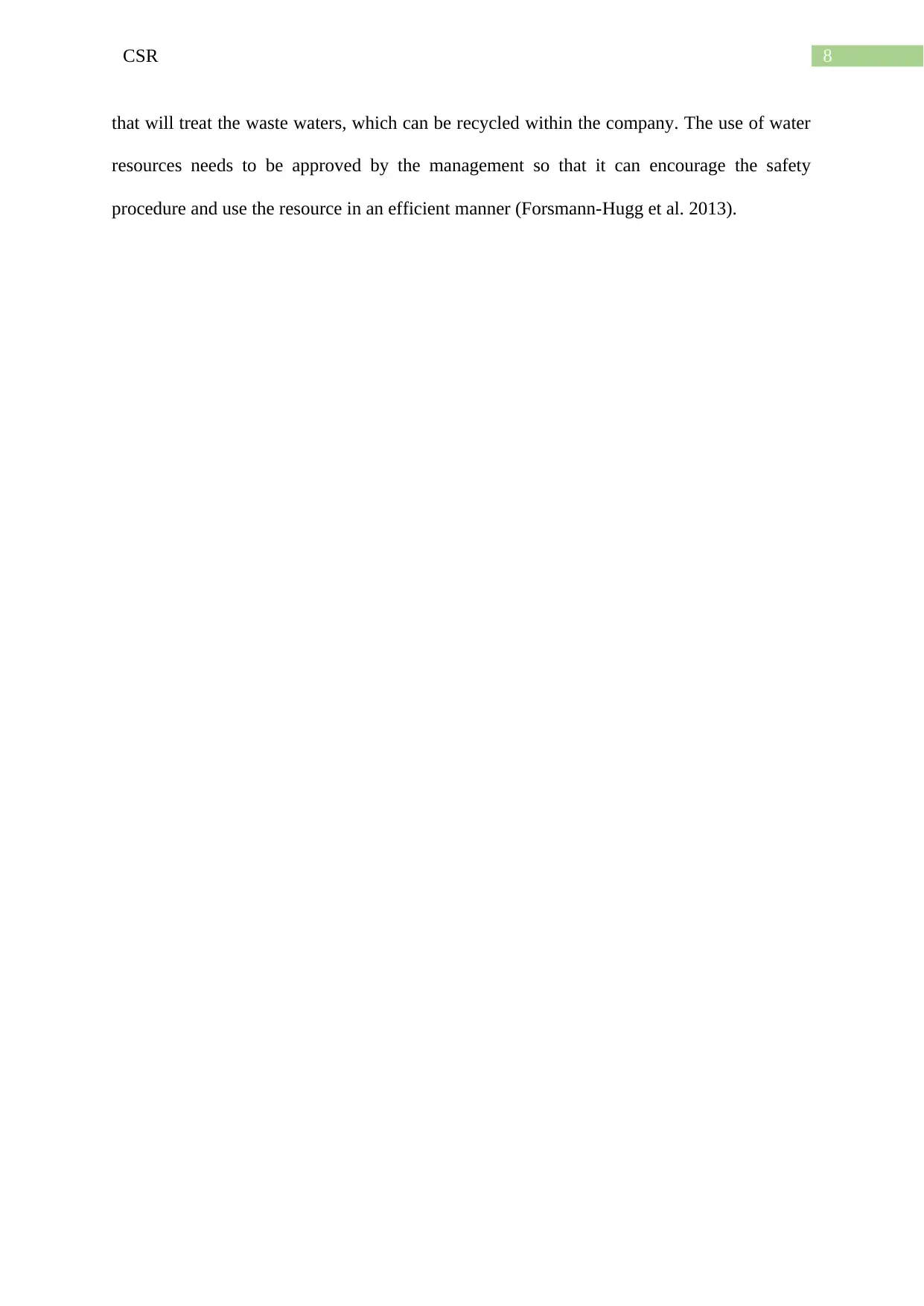
8CSR
that will treat the waste waters, which can be recycled within the company. The use of water
resources needs to be approved by the management so that it can encourage the safety
procedure and use the resource in an efficient manner (Forsmann-Hugg et al. 2013).
that will treat the waste waters, which can be recycled within the company. The use of water
resources needs to be approved by the management so that it can encourage the safety
procedure and use the resource in an efficient manner (Forsmann-Hugg et al. 2013).
⊘ This is a preview!⊘
Do you want full access?
Subscribe today to unlock all pages.

Trusted by 1+ million students worldwide
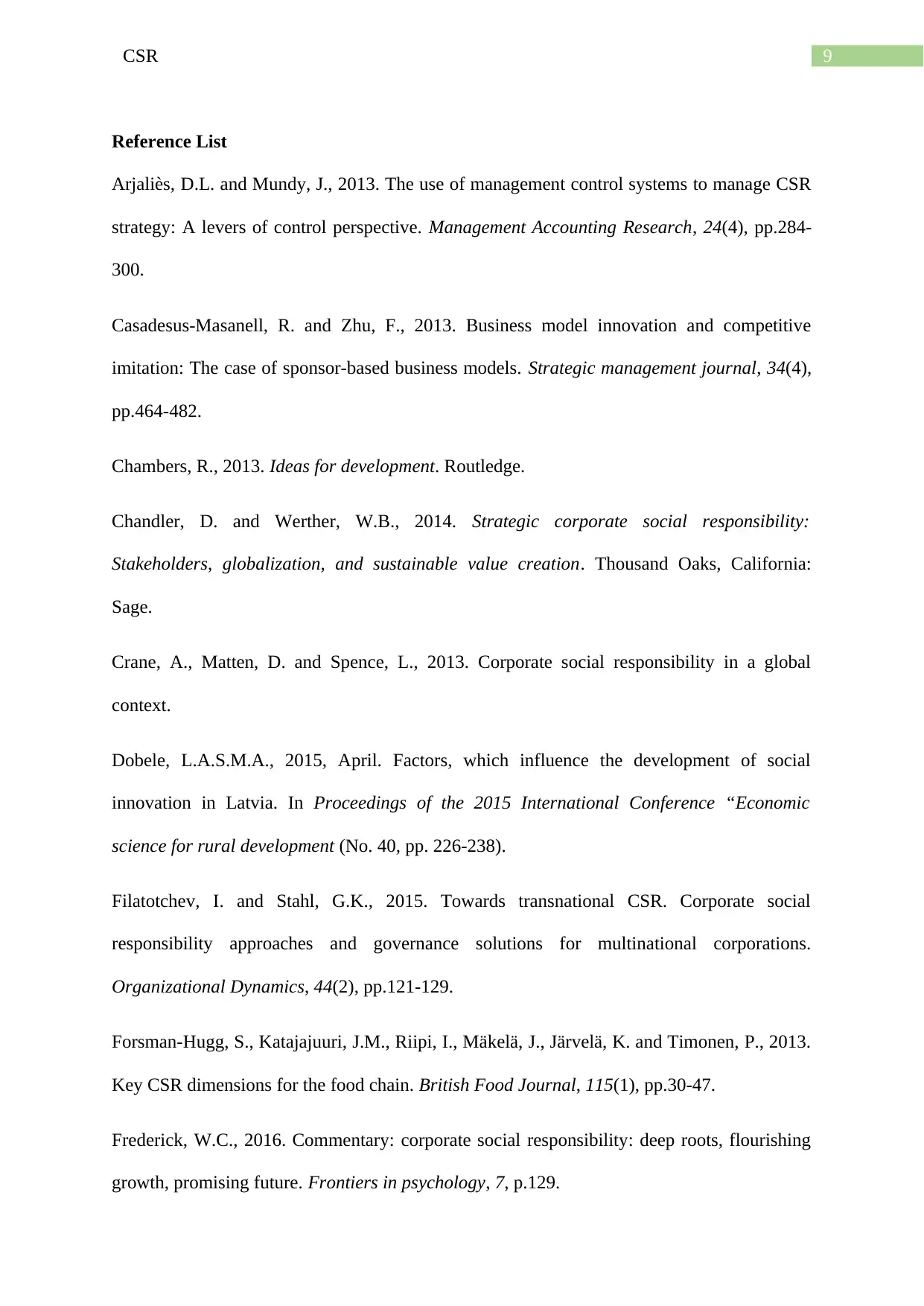
9CSR
Reference List
Arjaliès, D.L. and Mundy, J., 2013. The use of management control systems to manage CSR
strategy: A levers of control perspective. Management Accounting Research, 24(4), pp.284-
300.
Casadesus‐Masanell, R. and Zhu, F., 2013. Business model innovation and competitive
imitation: The case of sponsor‐based business models. Strategic management journal, 34(4),
pp.464-482.
Chambers, R., 2013. Ideas for development. Routledge.
Chandler, D. and Werther, W.B., 2014. Strategic corporate social responsibility:
Stakeholders, globalization, and sustainable value creation. Thousand Oaks, California:
Sage.
Crane, A., Matten, D. and Spence, L., 2013. Corporate social responsibility in a global
context.
Dobele, L.A.S.M.A., 2015, April. Factors, which influence the development of social
innovation in Latvia. In Proceedings of the 2015 International Conference “Economic
science for rural development (No. 40, pp. 226-238).
Filatotchev, I. and Stahl, G.K., 2015. Towards transnational CSR. Corporate social
responsibility approaches and governance solutions for multinational corporations.
Organizational Dynamics, 44(2), pp.121-129.
Forsman-Hugg, S., Katajajuuri, J.M., Riipi, I., Mäkelä, J., Järvelä, K. and Timonen, P., 2013.
Key CSR dimensions for the food chain. British Food Journal, 115(1), pp.30-47.
Frederick, W.C., 2016. Commentary: corporate social responsibility: deep roots, flourishing
growth, promising future. Frontiers in psychology, 7, p.129.
Reference List
Arjaliès, D.L. and Mundy, J., 2013. The use of management control systems to manage CSR
strategy: A levers of control perspective. Management Accounting Research, 24(4), pp.284-
300.
Casadesus‐Masanell, R. and Zhu, F., 2013. Business model innovation and competitive
imitation: The case of sponsor‐based business models. Strategic management journal, 34(4),
pp.464-482.
Chambers, R., 2013. Ideas for development. Routledge.
Chandler, D. and Werther, W.B., 2014. Strategic corporate social responsibility:
Stakeholders, globalization, and sustainable value creation. Thousand Oaks, California:
Sage.
Crane, A., Matten, D. and Spence, L., 2013. Corporate social responsibility in a global
context.
Dobele, L.A.S.M.A., 2015, April. Factors, which influence the development of social
innovation in Latvia. In Proceedings of the 2015 International Conference “Economic
science for rural development (No. 40, pp. 226-238).
Filatotchev, I. and Stahl, G.K., 2015. Towards transnational CSR. Corporate social
responsibility approaches and governance solutions for multinational corporations.
Organizational Dynamics, 44(2), pp.121-129.
Forsman-Hugg, S., Katajajuuri, J.M., Riipi, I., Mäkelä, J., Järvelä, K. and Timonen, P., 2013.
Key CSR dimensions for the food chain. British Food Journal, 115(1), pp.30-47.
Frederick, W.C., 2016. Commentary: corporate social responsibility: deep roots, flourishing
growth, promising future. Frontiers in psychology, 7, p.129.
Paraphrase This Document
Need a fresh take? Get an instant paraphrase of this document with our AI Paraphraser
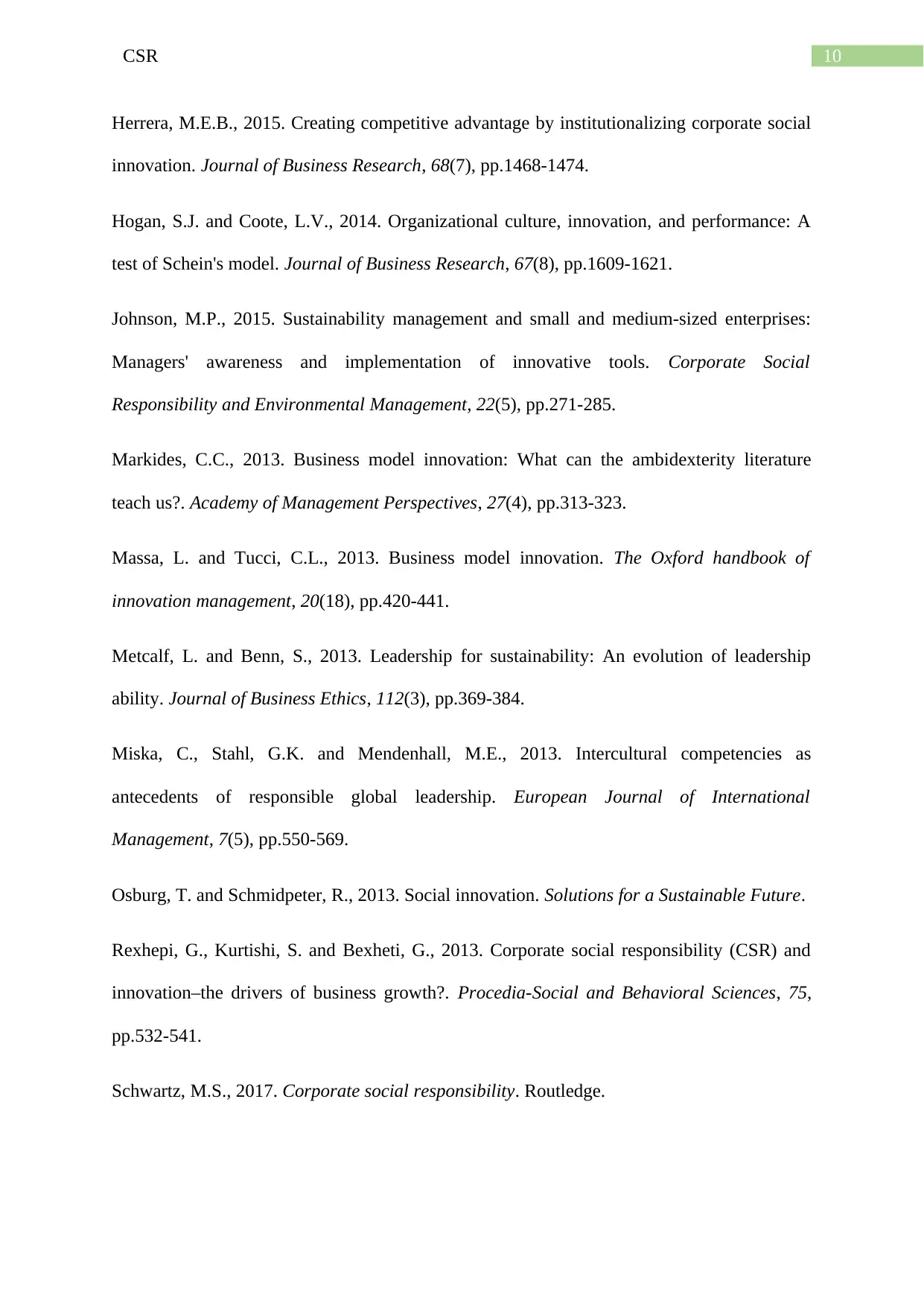
10CSR
Herrera, M.E.B., 2015. Creating competitive advantage by institutionalizing corporate social
innovation. Journal of Business Research, 68(7), pp.1468-1474.
Hogan, S.J. and Coote, L.V., 2014. Organizational culture, innovation, and performance: A
test of Schein's model. Journal of Business Research, 67(8), pp.1609-1621.
Johnson, M.P., 2015. Sustainability management and small and medium‐sized enterprises:
Managers' awareness and implementation of innovative tools. Corporate Social
Responsibility and Environmental Management, 22(5), pp.271-285.
Markides, C.C., 2013. Business model innovation: What can the ambidexterity literature
teach us?. Academy of Management Perspectives, 27(4), pp.313-323.
Massa, L. and Tucci, C.L., 2013. Business model innovation. The Oxford handbook of
innovation management, 20(18), pp.420-441.
Metcalf, L. and Benn, S., 2013. Leadership for sustainability: An evolution of leadership
ability. Journal of Business Ethics, 112(3), pp.369-384.
Miska, C., Stahl, G.K. and Mendenhall, M.E., 2013. Intercultural competencies as
antecedents of responsible global leadership. European Journal of International
Management, 7(5), pp.550-569.
Osburg, T. and Schmidpeter, R., 2013. Social innovation. Solutions for a Sustainable Future.
Rexhepi, G., Kurtishi, S. and Bexheti, G., 2013. Corporate social responsibility (CSR) and
innovation–the drivers of business growth?. Procedia-Social and Behavioral Sciences, 75,
pp.532-541.
Schwartz, M.S., 2017. Corporate social responsibility. Routledge.
Herrera, M.E.B., 2015. Creating competitive advantage by institutionalizing corporate social
innovation. Journal of Business Research, 68(7), pp.1468-1474.
Hogan, S.J. and Coote, L.V., 2014. Organizational culture, innovation, and performance: A
test of Schein's model. Journal of Business Research, 67(8), pp.1609-1621.
Johnson, M.P., 2015. Sustainability management and small and medium‐sized enterprises:
Managers' awareness and implementation of innovative tools. Corporate Social
Responsibility and Environmental Management, 22(5), pp.271-285.
Markides, C.C., 2013. Business model innovation: What can the ambidexterity literature
teach us?. Academy of Management Perspectives, 27(4), pp.313-323.
Massa, L. and Tucci, C.L., 2013. Business model innovation. The Oxford handbook of
innovation management, 20(18), pp.420-441.
Metcalf, L. and Benn, S., 2013. Leadership for sustainability: An evolution of leadership
ability. Journal of Business Ethics, 112(3), pp.369-384.
Miska, C., Stahl, G.K. and Mendenhall, M.E., 2013. Intercultural competencies as
antecedents of responsible global leadership. European Journal of International
Management, 7(5), pp.550-569.
Osburg, T. and Schmidpeter, R., 2013. Social innovation. Solutions for a Sustainable Future.
Rexhepi, G., Kurtishi, S. and Bexheti, G., 2013. Corporate social responsibility (CSR) and
innovation–the drivers of business growth?. Procedia-Social and Behavioral Sciences, 75,
pp.532-541.
Schwartz, M.S., 2017. Corporate social responsibility. Routledge.
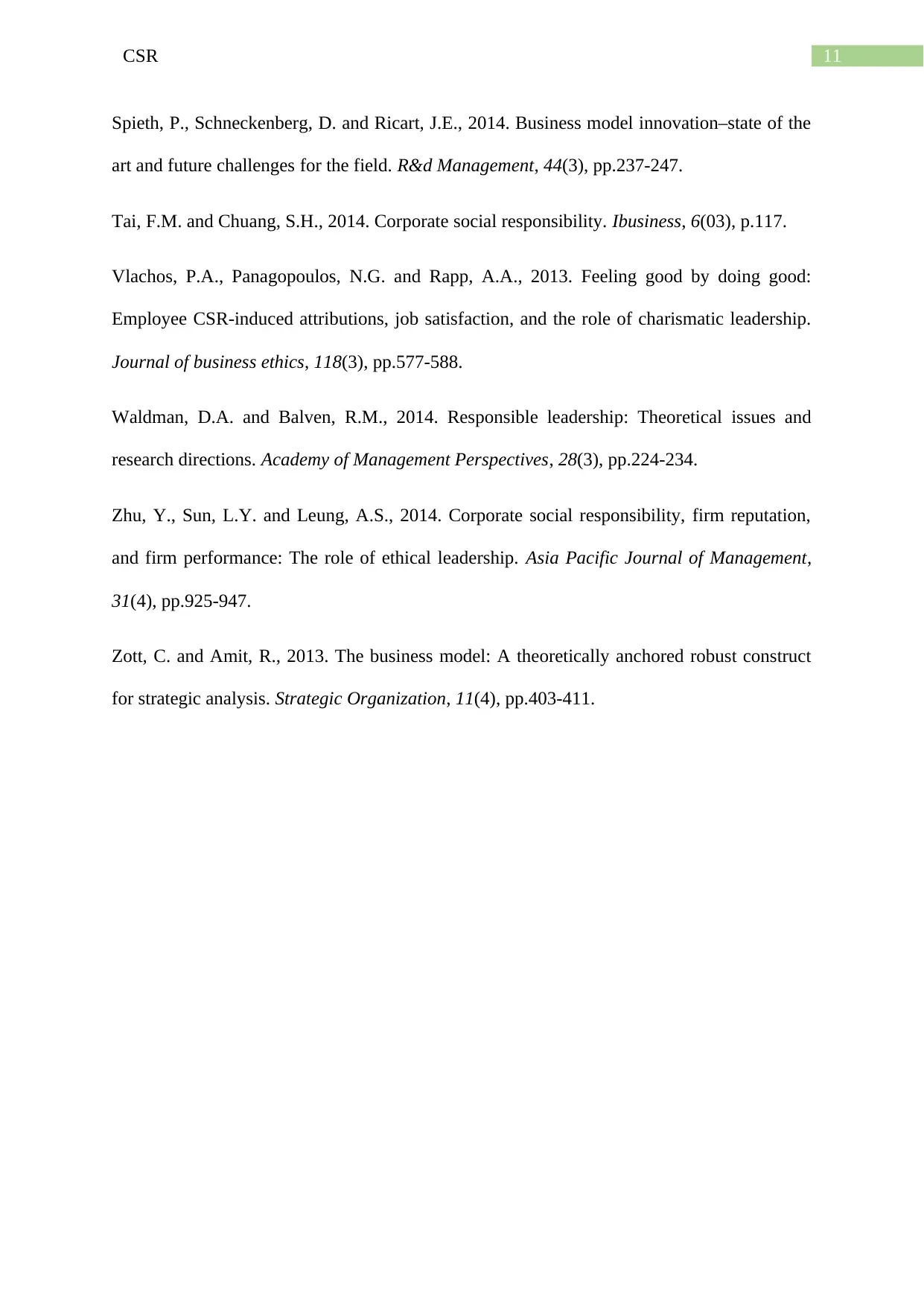
11CSR
Spieth, P., Schneckenberg, D. and Ricart, J.E., 2014. Business model innovation–state of the
art and future challenges for the field. R&d Management, 44(3), pp.237-247.
Tai, F.M. and Chuang, S.H., 2014. Corporate social responsibility. Ibusiness, 6(03), p.117.
Vlachos, P.A., Panagopoulos, N.G. and Rapp, A.A., 2013. Feeling good by doing good:
Employee CSR-induced attributions, job satisfaction, and the role of charismatic leadership.
Journal of business ethics, 118(3), pp.577-588.
Waldman, D.A. and Balven, R.M., 2014. Responsible leadership: Theoretical issues and
research directions. Academy of Management Perspectives, 28(3), pp.224-234.
Zhu, Y., Sun, L.Y. and Leung, A.S., 2014. Corporate social responsibility, firm reputation,
and firm performance: The role of ethical leadership. Asia Pacific Journal of Management,
31(4), pp.925-947.
Zott, C. and Amit, R., 2013. The business model: A theoretically anchored robust construct
for strategic analysis. Strategic Organization, 11(4), pp.403-411.
Spieth, P., Schneckenberg, D. and Ricart, J.E., 2014. Business model innovation–state of the
art and future challenges for the field. R&d Management, 44(3), pp.237-247.
Tai, F.M. and Chuang, S.H., 2014. Corporate social responsibility. Ibusiness, 6(03), p.117.
Vlachos, P.A., Panagopoulos, N.G. and Rapp, A.A., 2013. Feeling good by doing good:
Employee CSR-induced attributions, job satisfaction, and the role of charismatic leadership.
Journal of business ethics, 118(3), pp.577-588.
Waldman, D.A. and Balven, R.M., 2014. Responsible leadership: Theoretical issues and
research directions. Academy of Management Perspectives, 28(3), pp.224-234.
Zhu, Y., Sun, L.Y. and Leung, A.S., 2014. Corporate social responsibility, firm reputation,
and firm performance: The role of ethical leadership. Asia Pacific Journal of Management,
31(4), pp.925-947.
Zott, C. and Amit, R., 2013. The business model: A theoretically anchored robust construct
for strategic analysis. Strategic Organization, 11(4), pp.403-411.
⊘ This is a preview!⊘
Do you want full access?
Subscribe today to unlock all pages.

Trusted by 1+ million students worldwide
1 out of 12
Related Documents
Your All-in-One AI-Powered Toolkit for Academic Success.
+13062052269
info@desklib.com
Available 24*7 on WhatsApp / Email
![[object Object]](/_next/static/media/star-bottom.7253800d.svg)
Unlock your academic potential
Copyright © 2020–2025 A2Z Services. All Rights Reserved. Developed and managed by ZUCOL.





